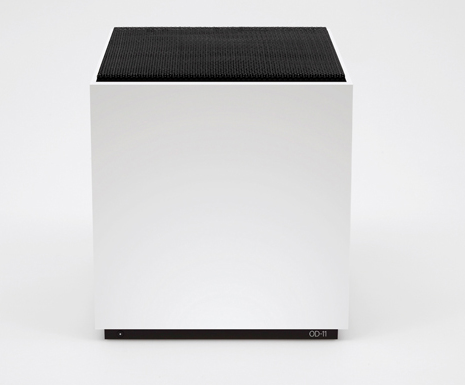
Ultra low power (ULP) RF specialist Nordic Semiconductor ASA that Swedish design specialist, Teenage Engineering, has specified a pair of Nordic nRF51822 System-on-Chips (SoCs) in the Bluetooth low energy RF remote control of its 100-Watt OD-11 cloud audio and network streaming active (self-amplifying) hi-fi speaker.
Cloud audio is becoming an increasing popular way for consumers to enjoy music via on-line services such as Spotify, Google Play, and SoundCloud, that offer streaming access to millions of songs and performers for that a user can access from all of their connected device.
In operation, the cube shaped (26cm long-wide-tall) OD-11 streams audio over Wi-Fi from a host device (although 3.5mm jack and optical inputs are also included). It can also operate standalone (apart from a single power cord) in any part of a room thanks to the use of an omni-directional speaker design originally pioneered by Swedish audio engineer, Stig Carlsson, in the 1970s (Teenage Engineering says the original OD-11s sold over 100,000 units in Sweden alone and became icons of their time).
This speaker design is claimed to produce a much higher quality of sound reproduction in regular rooms than conventional speakers that have been developed in acoustically optimized (reflection damped) sound studios and has now been fully modernized by Teenage Engineering using the latest hi-fi filters and DSPs (digital signal processors).
"We wanted to give people hi-fidelity sound quality without them having to get involved with hi-fi, which typically means having to worry about amplification, speakers, speaker positioning, cabling, interconnects, source player(s), DACs, streaming-compatibilities, and so on," says Emil Kullänger, PR & Marketing Manager, Teenage Engineering. "Instead the OD-11 was designed to be the simplest possible hi-fi audio solution on the market today combining the convenience of cloud music access with genuine hi-fi quality audio reproduction."
For larger rooms, or even further enhanced audio reproduction, up to four OD-11s can be connected together and the volume of all can be controlled from a single hockey-puck shaped RF remote control that through the use of Bluetooth low energy wireless technology can control the OD-11s from adjacent rooms. The remote control includes a magnetic housing that allows it to stick to metallic surfaces such as refrigerator doors. The OD-11 remote will also immediately start playing from where the end user left of and can remember all songs played to date if the user wants to click back to them.
The class-leading, ultra low power operating performance of Nordic's nRF51822 SoCs enables the OD-11's RF remote to offer a one-year-plus battery life from a pair of regular AAA batteries.
"We selected the Nordic Semiconductor nRF51822 because it was the most flexible yet power efficient solution we could find through our own research," adds Jens Rudberg, Technical Director at Teenage Engineering. "This included talking to other electronics design engineers and companies and in-depth evaluations using eval kits from three other Bluetooth low energy chip vendors."
"At risk of repeating myself, IR [infra-red] remote control technology is over 30 years old and showing its age," comments Geir Langeland, Nordic Semiconductor's Director of Sales & Marketing. "And while RF offers a list of superior bandwidth, two-way comms, and responsiveness benefits over IR, its ability to eliminate the need for line-of-sight control and so allow devices to be controlled from adjacent rooms is proving to be extremely popular as the market for wireless audio grows and the conventional need for speakers and source equipment to be located in the same room starts to decline." |